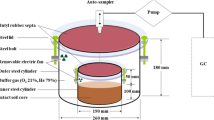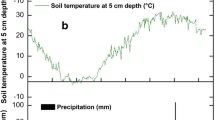Abstract
Soil N2O emissions were monitored throughout a 3-year crop rotation including maize, fennel and a ryegrass-clover sward, at Borgo Cioffi NitroEurope site. N2O emission rates were highly variable in time and space and controlled by soil nitrogen and soil water content. The N2O effluxes were low for most of the monitored period. The highest N2O emissions were recorded throughout the 2007 maize cropping season, ranged form 15.2 to 196.2 μg m−2 h−1 whereas the lowest ones ranged form −5 to 10 μg m−2 h−1 during the 2007–2008 ryegrass-clover winter crop. For the maize crops, N2O peaks were detected after fertilization but with a delay of some weeks from applications, probably due to the presence of DMPP nitrification inhibitor in the applied fertilizer. A properly designed ANOVA model was developed to explain the influence of the main chemical-physical factors. This model also allowed the quantification of the delay time in peak emissions following fertilization, which resulted variable over the years and ranged between 2 and 21 days. A dependence of emissions from soil temperature and moisture was found, with significant interactions in some instances. Calculated Emission Factors (maize 2007: 0.48%; ryegrass-clover sward 2007–2008: 0.05%; maize 2008: 0.14%; fennel: 0.28% 2008–2009; maize 2009: 0.015%) resulted well below the values reported in the literature and the 1% reference value indicated by IPCC, probably due to a sub-optimal water regime inducing low Water Filled Pore Space (WFPS) values.





Similar content being viewed by others
References
Bronson KF, Mosier AR, Bishnoi SR (1992) Nitrous oxide emissions in irrigated corn as affected by encapsulated calcium carbide and nitrapyrin. Soil Sci Soc Am J 56:161–165
Carter Mette S, Albert K, Ambus P (2009) Is organic farming a mitigation option?—A study on N2O emission from winter wheat. Abstract submitted to: Theme 3 The role of agriculture to mitigate climate change. http://orgprints.org/15846/2/15846_paper.pdf
Castaldi S (1997) Microbial processes contributing to N2O production in two sandy Scottish soils. Ph.D. Dissertation, University of Edinburgh
Chatskikh D, Olesen J, Berntsen J, Regina K, Yamulki S (2005) Simulation of effects of soils, climate and management on N2O emission from grasslands. Biogeochemistry 76:395–419
Conen F, Dobbie KE, Smith KA (2000) Predicting N2O emissions from agricultural land trough related soil parameters. Glob Chang Biol 6:417–426
Davidson EA (1991) Fluxes of nitrous oxide and nitric oxide from terrestrial ecosystem. In: Rogers JE, Whitman WB (eds) Microbial production and consumption of greenhouse gases: methane, nitrogen oxides and halomethanes. American Society for Microbiology Washington DC. pp 219–235
Davidson EA, Kingerlee W (1997) A global inventory of nitric oxide emissions from soil. Nutr Cyc Agroecosyst 48:37–50
Del Grosso SJ, Parton WJ, Mosier AR, Walsh MK, Ojima DS, Thornton PE (2006) DAYCENT national scale simulations of N2O emissions from cropped soils in the USA. J Environ Qual 35:1451–1460
Delgado JA, Mosier AR (1996) Mitigation alternatives to decrease nitrous oxide emissions and urea-nitrogen loss and their effect on methane flux. J Environ Qual 25:1105–1111
Dobbie K, Smith KA (2003) Nitrous oxide emission factors for agricultural soils in Great Britain: the impact of soil water-filled pore space and other controlling variables. Global Change Biol 9:204–218
Dobbie KE, McTaggart IP, Smith KA (1999) Nitrous oxide emissions from intensive agricultural systems: variations between crops and seasons, key driving variables, and mean emission factors. J Geophys Res 104:26891–26899
Forte A (2006) Denitrifier and nitrifier activities and N2O emission of fine and textured soil of a Mediterranean irrigated cropland in southern Italy. Ph.D. Dissertation, Università degli Studi di Napoli Federico II
Forte A, Riondino M, Fierro A, Virzo A, Fagnano M, Fiorentino N, Spaccini R, Piccolo A, Ranucci S, Ottaiano L, Di Tommasi P, Oliva M, Vitale L, Magliulo V, Bertolini T (2009) N2O Emissions from two mediterranean agricultural soils with similar sub-optimal irrigation regime and different n-input management. In: Grignani C, Acutis M, Zavattaro L, Bechini L, Bertora C, Marino Gallina P, Sacco D (eds) Proceedings of the 16th Nitrogen Workshop-Connecting different scales of nitrose use in agricoltural. 28th June–1st July 2009, Turin, Italy, pp 197–198
Gabrielle B, Laville P, Hénault C, Nicoullaud B, Germon JC (2006) Simulation of nitrous oxide emissions from wheat-cropped soils using CERES. Nutr Cyc Agroecosyst 74:133–146
Hutchinson GL, Mosier AR (1981) Improved soil cover method for field measurements of nitrous oxide fluxes. Soil Sci Soc Am J 45:311–16
IPCC (2006) IPCC Guidelines for National Greenhouse Gas Inventories. Prepared by the National Greenhouse Gas Inventories Programme. In: Eggleston HS, Buendia L, Miwa K, Ngara T, Tanabe K (eds). Published: IGES, Japan
IPCC (2007) Climate change 2007: Mitigation. Contribution of working group III to the fourth assessment report of the intergovernmental panel on climate change. In: Metz B, Davidson OR, Bosch PR, Dave R (eds)
Jian-gang H, Yong-li Z, Hong-ying B, Dong Q, Jin-yu C, Chun-du W (2007) N2O emission under different moisture and temperature regimes. Bull Environ Contam Toxicol 78:284–287. doi:10.1007/s00128-007-9118-6
Jingyan J, Hu Z, Sun W, Huang Y (2010) Nitrous oxide emissions from Chinese cropland fertilized with a range of slow-release nitrogen compounds. Agr Ecosyst Environ 135:216–225
Kim DS, Harazono Y, Baten MA, Nagai TH (2002) Surface flux measurements of CO2 and N2O from a dried rice paddy in Japan during a fallow winter season. J Air Waste Manage Assoc 52:416–422
Kroeze C, Mosier A (2000) New estimates for emissions of nitrous oxide. In: van Ham APM, Baede, Meyer LA, Ybema R (eds) Non-CO2 greenhouse gases: scientific understanding, control and implementation. Kluwer Academic, The Netherlands, pp 45–64
Lee J, Hopmans JW, Kessel CV, King AP, Evatt KJ, Louie D, Rolston DE, Six J (2008) Tillage and seasonal emissions of CO2, andN2O and NO across a seed bed and at the field scale in a Mediterranean climate. Agr Ecosyst Environ 129:378–390
Li CS (2000) Modelling trace gas emissions from agricultural ecosystems. Nutr Cyc Agroecosyst 58:259–276
Matson PA (1997) NOx emission from soils and its consequences for the atmosphere and biosphere: critical gaps and research directions for the future. Nutr Cycl Agroecosyst 48:1–6
McSwiney C, Robertson G (2005) Nonlinear response of N2O flux to incremental fertilizer addition in a conditinuous maize (Zea mays L.) cropping system. Global Change Biol 11:1712–1719. doi:10.1111/j1365-2486.2005.01040.x
Mosier AR, Guenzi WD, Schweizer EE (1986) Soil losses of dinitrogen and nitrous oxide from irrigated crops in Northeastern Colorado. Soil Sci Soc Am J 50:344–348
Mosier A, Duxbury J, Freney J, Heinemeyer O, Minami K (1996) Nitrous oxide emissions from agricultural fields: assessment, measurement and mitigation. Plant Soil 181:95–108
Mosier AR, Halvorson AD, Reule CA, Liu XJ (2006) Net global warming potential and greenhouse gas intensity in irrigated cropping systems in Northeastern Colorado. J Environ Qual 35:1584–1598. doi:10.2134/jeq2005.0232
Parton WJ, Holland EA, Del Grosso SJ, Hartman MD, Martin RE, Mosier AR, Ojima DS, Schimel DS (2001) Generalized model for NOx and N2O emissions from soils. J Geophys Res Atmos 106:17403–17419
Pfab H, Ruser R, Palmer I, Fiedler S, Buegger F, Muller T (2009) N2O Emissions from a high N-Input system as influenced by fertilizer amount and type. In: Grignani C, Acutis M, Zavattaro L, Bechini L, Bertora C, Marino Gallina P, Sacco D (eds) Proceedings of the 16th Nitrogen Workshop-Connecting different scales of nitrous use in agricultural. 28th June–1st July 2009, Turin, Italy, pp 197–198
Ranucci S (2009) Monitoraggio delle emissioni di gas ad effetto serra (N2O e CH4) da suoli agricoli in funzione della gestione e delle variabili chimico-fisiche in ambiente mediterraneo. Ph.D. Dissertation, Università degli Studi di Napoli Federico II
Rowell DL (1993) Soil science: methods and applications. Longman Ltd, 61
Ruser R, Flessa H, Russow R, Schmidt G, Buegger F, Munch JC (2006) Emission of N2O, N2 and CO2 from soil fertilized with nitrate: effect of compaction, soil moisture and rewetting. Soil Biol Biochem 38:263–274
Sehy U, Ruser R, Munch JC (2003) Nitrous oxide fluxes from maize fields: relationship to yield, site-specific fertilization, and soil conditions. Agr Ecosyst Environ 99:97–111
Skiba U, Smith KA, Fowler D (1993) Nitrification and denitrification as sources of nitric oxide and nitrous oxide in a sandy loam soil. Soil Biol Biochem 25:1527–1536
Smith KA, Clayton H, McTaggart IP, Thomson PE, Arah JRM, Scott A (1995) The measurement of nitrous oxide emissions from soil by using chambers. Philos Trans R Soc Lond 351:327–38
Smith KA, McTaggart IP, Dobbie KE, Conen F (1998) Emissions of N2O from Scottish agricultural soils, as a function of fertilize N. Nutr Cyc Agroecosyst 52:123–130
Snyder CS, Bruulsema TW, Jensen TL (2007) Greenhouse gas emissions from cropping systems and the influence of fertilizer management-a literature review. International Plant Nutrition Institute, Norcross, Georgia, U.S.A.
Vallejo A, Diez JA, Lopez-Valdivia LM, Cartagena MC, Tarquis A, Hernàiz P (2004) Denitrification from an irrigated soil fertilized with pig slurry under Mediterranean conditions. Biol Fertil Soils 40:93–100
Vallejo A, Garcia-Torres L, Diez JA, Arce A, Lòpez-Fernàndez S (2005) Comparison of N losses (NO −3 , N2O, NO) from surface apllied injectedor amended (DCD) pig slurry of an irrigated soil in a Mediterranean climate. Plant Soil 272:313–325. doi:10.1007/s11104-004-5754-3
van Groenigen JW, Kasper GJ, Velthof GL, van den Pol-van Dasselaar A, Kuikman PJ (2004) Nitrous oxide emissions from silage maize fields under different mineral nitrogen fertilizer and slurry applications. Plant Soil 26:101–111
Vitale L, Di Tommasi P, Arena C, Riondino M, Forte A, Verlotta A, Fierro A, Virzo De Santo A, Fuggi A, Magliulo V (2009) Growth and gas exchange response to water shortage of a maize crop on different soil types. Acta Physiol Plant 31:331–341
Weiske A, Vabitsch A, Olesen JE, Schelde K, Michel J, Friedrich R, Kaltschmitt M (2006) Mitigation of greenhouse gas emissions in European conventional and organic dairy farming. Agr Ecosyst Environ 112:221–2321
Acknowledgments
Thanks are due to Dr. Gaetano Iemma for his kindness in hosting the work on his farm; Dr. Vincenzo Carbone for the crop management; Dr. Grazia Convertini (ISA-CRA, Bari, Italy) for the soil nitrogen analysis; Dr. Simona Castaldi for the gas chromatograph analyzer; Mss. Angela Balsamo and Mr. Filippo Busiello (ISAFoM-CNR) for their useful assistance during soil sampling and biometrical analysis. Authors wish to thank the anonymous referees who contributed to improve the paper with their comments. This study was partly funded by CarboItaly national program.
Author information
Authors and Affiliations
Corresponding author
Additional information
Responsible Editor: Per Ambus.
Rights and permissions
About this article
Cite this article
Ranucci, S., Bertolini, T., Vitale, L. et al. The influence of management and environmental variables on soil N2O emissions in a crop system in Southern Italy. Plant Soil 343, 83–96 (2011). https://doi.org/10.1007/s11104-010-0674-x
Received:
Accepted:
Published:
Issue Date:
DOI: https://doi.org/10.1007/s11104-010-0674-x




